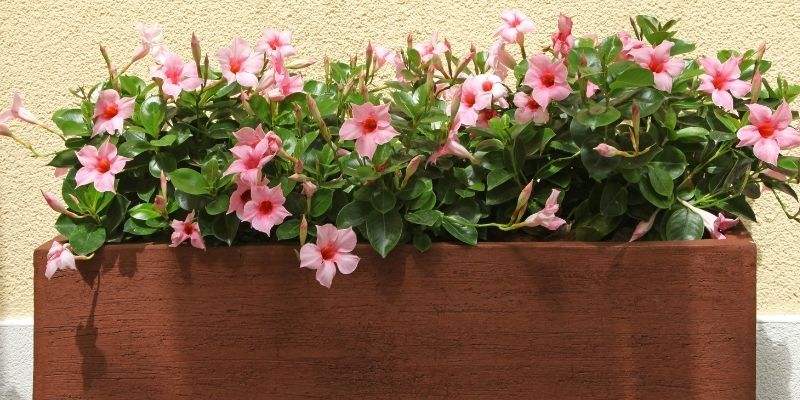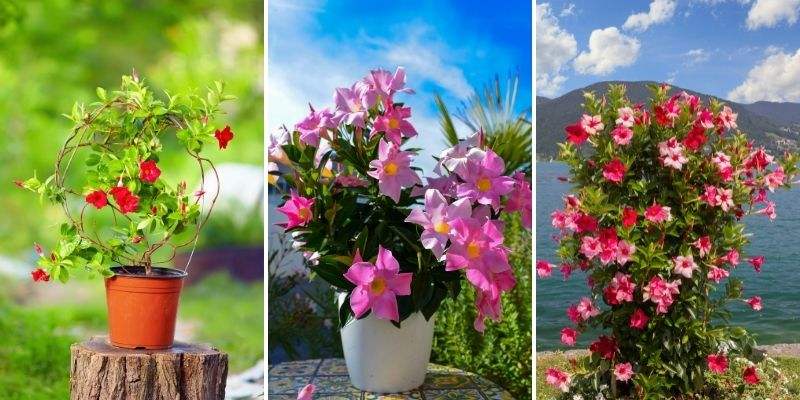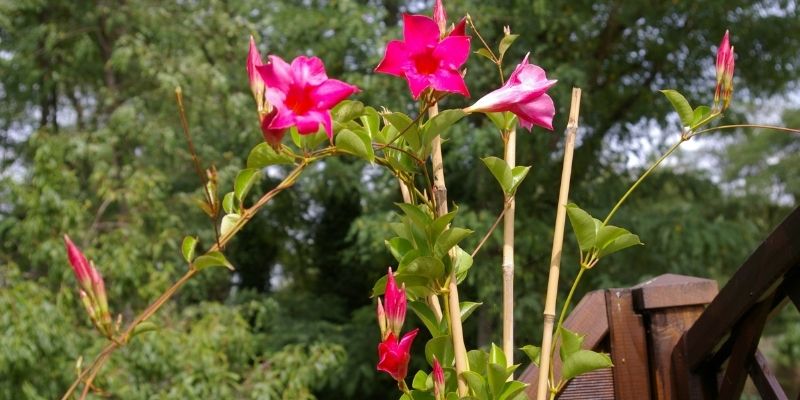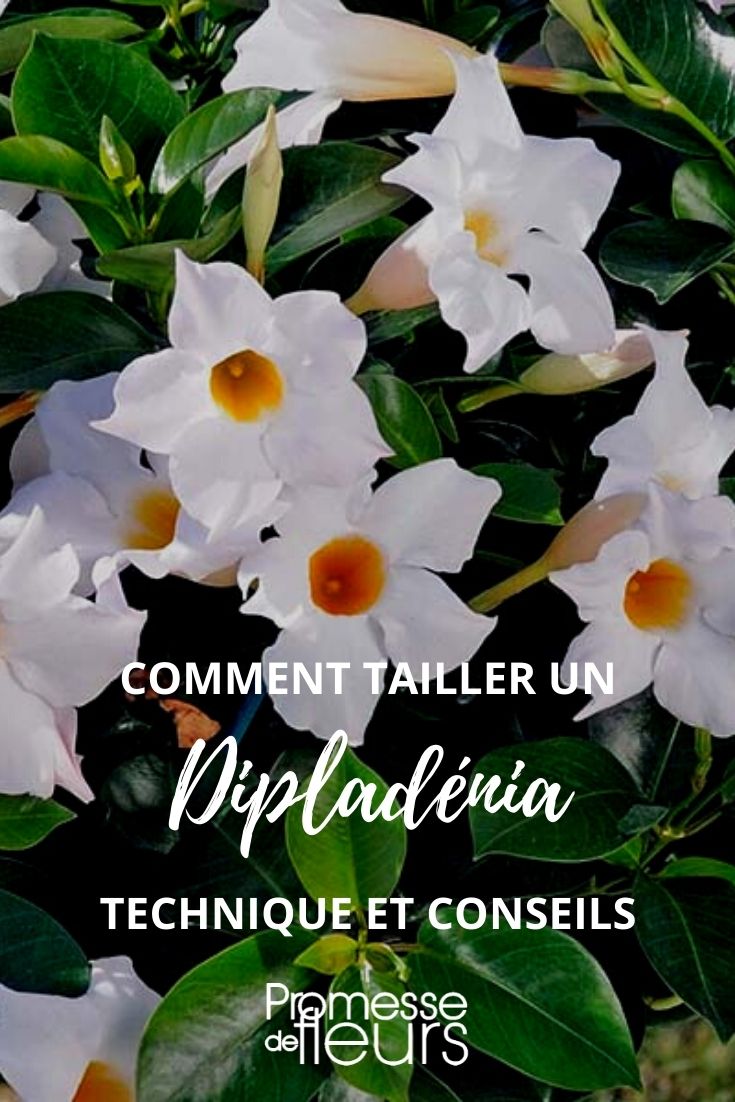Plant with evergreen foliage and superb star‑shaped trumpet flowers, the dipladenia (or Brazilian jasmine) brings colour and exoticism from early summer to first frosts. Not very hardy, in colder regions mandevilla is grown as an annual in garden or container and can then be brought indoors for winter. In regions with mild climate it can be planted in ground, in a flowerbed, a border or a rockery. Able to withstand summer heat, with low water needs and fairly rapid growth, note that dipladenias require regular pruning to keep attractive appearance and vigour, and also to obtain generous flowering. Because dipladenia flowers form on current year’s young shoots, maintenance pruning must be timed correctly to avoid compromising flowering. Discover our tips to successfully prune your dipladenia, whether climbing or bushy!

This dipladenia in a planter has a nice shape and homogeneous flowering thanks to pruning.
Why prune dipladenia?
Pruning dipladenia is not obligatory, but strongly recommended for several reasons. Annual pruning is important aesthetically, but it also has an invigorating effect. It helps maintain a compact, bushy habit by stimulating production of young shoots. Upcoming flowering is then more abundant. Finally, by removing dead or diseased parts, plant has better chances of staying healthy and living longer.

On left, a frail, poorly branched dipladenia. Centre: a potted dipladenia with compact, bushy habit. Right: a dipladenia trained on its support bearing numerous flowers.
When to prune dipladenia?
Best time to prune dipladenia is late winter (February/March), before growth resumes. Older specimens (minimum 3 years) are rejuvenated at this time. Regular pinching of tips of young shoots is necessary to encourage flowering. This is also the right time to repot your dipladenia (every 1 to 2 years).
At end of autumn, after flowering, if dipladenia is too large you can prune to reduce size before overwintering indoors. Moreover, if storage location is dark, cutting back is necessary to promote branching and encourage flowering next year. This climbing plant likes light; overwintering in darkness will delay flowering. Winter pruning will help restart in spring.
Throughout flowering, remove faded flowers to encourage new blooms. During growth period, let dipladenia develop freely, do not prune. Support long stems as they lengthen. Shorten only stems that become problematic and can no longer be guided on support.
Tools for pruning dipladenia
Use a clean, well‑disinfected and very sharp pruning shear to avoid disease transmission to your dipladenia. Ensure cuts are clean when pruning. Because of its white toxic, sticky and irritating sap that runs from shoots during pruning, wear a pair of gloves.
How to prune dipladenias?
Maintenance pruning of dipladenias
- Begin by removing dry, dead or diseased stems and leaves.
- Using pruning shear, cut back the longest voluble secondary shoots (thin, green) to 3 or 4 buds from main stems (thick, brown and grey). Always cut above a bud or a shoot.
- Cut back to the base any main branches that are entirely dead. Note dipladenia has good ability to produce vigorous new shoots from the stump. If dipladenia spread is unsuitable and it grows too tall, you can perform a harder prune by cutting main stems (also called scaffold branches) back by half.
- Remove remaining faded flowers and pod‑shaped fruits if any remain.
- Once maintenance pruning is finished, adjust substrate level and train stems on support.

Here, an older brown stem is visible on the left and a young green stem on the right.
Pinching dipladenias
Pinching consists of removing terminal bud at tip of a stem. Carry out pinching every 4 to 5 weeks. Take tip of a young stem between thumb and forefinger. Pinch with nails to sever (cut about 3–4 centimetres of stem). Plant will then branch, producing new shoots and providing more flowers. For young specimens still small, regular pinching is sufficient; maintenance pruning is not necessary.
How to make a dipladenia climb?
Semi‑climbing or climbing dipladenias can be used in two ways: as a trailing plant (for example in a hanging basket or on a low wall where they cascade) or as a climbing plant. In this second case, dipladenia needs to be trained on a support at planting. Installing support at that time avoids root damage. Indeed, if you put support after plant is well rooted, you risk damaging root system. There is a wide choice of supports in various shapes and materials (wood, bamboo, metal): trellis, pergola, mesh, arch, column, tipi. Place support first and ensure it is well anchored, then plant your dipladenia. Guide voluble stems onto support, distributing them evenly (naturally, stems wind anticlockwise). Handle them gently. You can tie them with natural ties (raffia, string), without tightening too much. Continue directing stems as plant grows.
Further reading
- Find our range of dipladenias on our site, as well as a selection of climbing plants
- To preserve your dipladenia, see our sheet Dipladenia in winter: protecting it from cold
- Follow our 10 tips for successful cultivation of dipladenia
































Comments